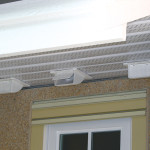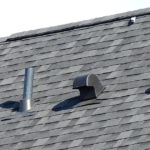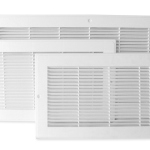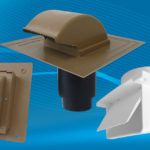 When choosing a spot to place an HVAC intake or exhaust vent, soffits can provide a convenient solution. The eaves of a roof can be used to help hide vent caps, and also play a vital role in proper attic ventilation. Still, it’s important for builders to carefully consider the purpose of a vent before deciding which cap will fit their specific purpose.
When choosing a spot to place an HVAC intake or exhaust vent, soffits can provide a convenient solution. The eaves of a roof can be used to help hide vent caps, and also play a vital role in proper attic ventilation. Still, it’s important for builders to carefully consider the purpose of a vent before deciding which cap will fit their specific purpose.
The most common use for soffit vents is to encourage air circulation in an attic. Working in combination with roof and ridge vents, air is drawn through the soffits and vented out near the peaks of a roof. This airflow discourages rot and mildew by preventing moisture from being trapped.
It will also help keep a home cooler in the summer, while reducing the likelihood of ice jams in the winter. Vent covers can be relatively simple, but should provide a screen to prevent animals from climbing inside. A design with a removable screen may also provide significant advantages for future cleaning.
When installing a vent in a soffit from something like a dryer, bathroom fan or range hood, things become a little more complicated. That’s because it’s important to direct moist or dirty discharged air away from the home so it is not drawn back inside. That requires a vent cap with a hood to deflect the air away from the eaves.
The cap should have a damper, or flap which seals tightly when the fan is not in use, but opens freely when airflow is required. One piece plastic options improve on the leaky dampers and extra hardware present in metal versions and help improve efficiency by reducing heat loss.
Screens can also be incorporated in one piece plastic designs to help keep varmints out, but remember screens should be avoided on dryer vents which could become clogged with lint.
When venting ducts to the outdoors through a soffit on the underside of a concrete slab, a lower profile vent hood may be important.
A long, wide opening will still allow plenty of air to pass through without requiring the regular cleaning of slab vent covers made using metal.
Another challenge is venting a soffit in a low slope roof as finding the proper elbow to terminate your duct in such tight spaces can be difficult. Fortunately, low profile squeeze elbows are available to help accommodate a variety of roof pitches, and designs.
Soffit vents are not ideal in all cases, but if builders take the time to learn about the purpose-built vent caps available, they should find a solution for most applications.



